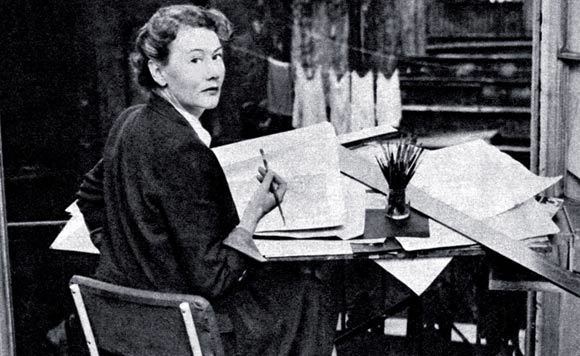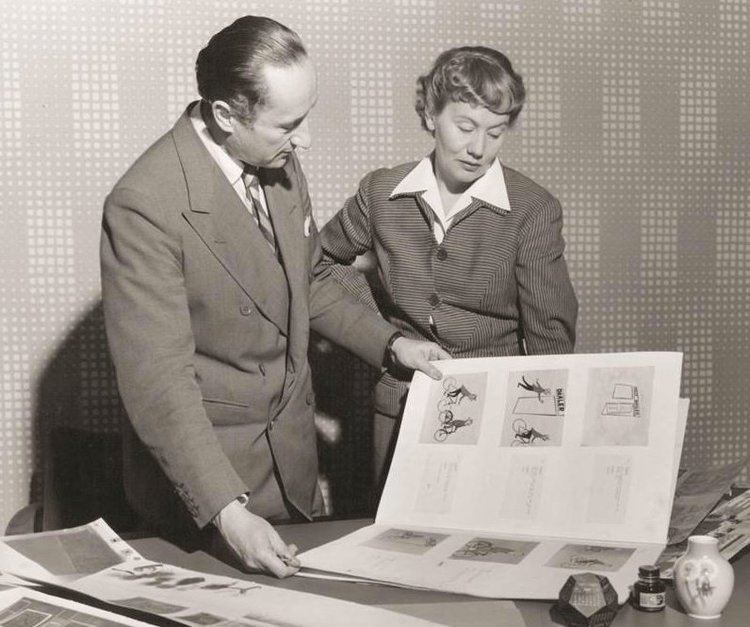Name Joy Batchelor Role Animator | ||
 | ||
Died May 14, 1991, London, United Kingdom Movies Animal Farm, Your Very Good Health, The Candlemaker, Automania 2000, The Magic Canvas Similar People John Halas, Maurice Denham, Borden Mace, Gordon Heath, Matyas Seiber | ||
Joy Batchelor
Joy Batchelor (12 May 1914 – 14 May 1991) was an English animator, director, screenwriter, and producer. She married John Halas in 1940 and subsequently co-established Halas and Batchelor cartoons, whose best known production is the animated feature film Animal Farm (1954). Together they created over 2000 shorts/films, and produced roughly 70 propaganda pieces during World War II for the British government. She helped co-write, write, animate, produce, and direct many of their productions.
Contents
- Joy Batchelor
- Joy batchelor an animated life introduction
- Early life
- Career
- Halas and Batchelor
- Animal Farm
- After Animal Farm
- Retirement and Death
- References

One of her projects as an art director was Cinerama Holiday (1955). Joy directed and wrote Ruddigore (1967), a television-film adaptation of W.S. Gilbert's opera of the same name, which became the first opera to be adapted into an animated film. She later worked in television, directing series, including animated shows like The Jackson 5ive (1971). Batchelor died on 14 May 1991, just two days after her 77th birthday.

Joy batchelor an animated life introduction
Early life

Joy Batchelor was born May 12, 1914, in Watford, Hertfordshire. She attended Watford Grammar School for Girls and later attended Watford School of Art, Science and Commerce, to which she had won a scholarship. She was offered placement afterwards at the Slade School of Art, but did not continue schooling in order to help support her family financially. She worked as a commercial artist and assembly line worker.
Career

Batchelor began working in animation first as an in-betweener for Dennis Connolly's projects. As part of her work as a commercial artist, she also worked as a silk-screen printer and printed posters and assisted in design work for fashion magazines. She met John Halas through an advertisement he wrote, seeking an assistant animator for numerous works for British Colour Cartoons Limited. Batchelor accompanied him when the company sent Halas to Hungary in 1937 for work. Their first film together would be The Music Man (1937).

The company had financial issues and sent Batchelor and Halas back to the UK after half of year of working. Batchelor and Halas attempted to start a commercial art studio in Budapest, which was unsuccessful. They moved back to London where Batchelor resumed work as a freelance illustrator for books and magazines. Batchelor and Halas married April 27, 1940. Later that year, they establish Halas and Batchelor cartoons.
Halas and Batchelor

In the starting year of Halas and Batchelor, Joy Batchelor and John Halas continued to do commercial work to sustain finances. In 1940, Halas and Batchelor was approached by J. Walter Thompson to produce advertising shorts. Their first commissions consisted of commercials for Kellogg's cereal and Lux Soap, producing Train Trouble and Carnival in a Clothes Cupboard for each respectively.

Later in 1940, Halas and Batchelor was recruited by the Ministry of Information to help create propaganda and educational films for the war effort. Batchelor helped to co-write, co-direct, and animate most of the films produced during this time. This included films such as Dustbin Parade (1941) and Filling the Gap (1941). The company was busy during this time, producing roughly 70 films between 1940 and 1944. Batchelor helped inform these films with her knowledge of British lifestyle, as John Halas was a Hungarian immigrant.

After World War II, Halas and Batchelor continued to produce shorts for the government. Batchelor designed Charley, the titular character of the Charley series the company created for the Central Office of Information. The series purpose was to educate and persuade the audience towards the newly instated Labour Government's socialist-slanted policies. Her style is described as favoring the use of simplistic images and partially authoritative narration, which was note-worthy in the Charley series. For the Ministry of Health, her first film to be written just by her was Modern Guide to Health (1946). Their films were also part of the Economic Cooperation Administration's efforts to bolster favorable response to the Marshall Plan. Lothar Wolff, in charge of commissioning these films for the ECA, commissioned Halas and Batchelor to animate The Shoemaker and the Hatter (1949) to this end. Wolff later introduced their films to Louis de Rochemont, who worked with them to create Animal Farm.
Animal Farm
Joy Batchelor and John Halas shared in directing Animal Farm (1954). Batchelor worked on the preliminary treatments for the film, which were used to get the rights to create it. She had a leading role in writing the script and designing the characters.
In order to simplify and shorten the complex story of Animal Farm, she devised a breakdown chart and a tension chart. The breakdown chart was used to connect all the characters in Animal Farm to each other, as well as gauge their contribution to major plot points. The tension chart she created was described as a long sheet of paper outline the rise and fall of emotional tension in relation to the plot points as the story unfolded. It consisted of a short description of the scene along the top, followed by a visual depiction of how tension would build. It also included cues for the changes in intensity for the music. These charts helped in discerning which characters could be dropped from the film (such as Clover and Mollie) and which scenes could be shortened in order to still understand the story and conflict of Animal Farm. The film still resulted in being over the initial agreed upon time length, as well as taking three years to create. Animal Farm was Britain's first animated feature film.
After Animal Farm
In 1955, commercial television became much more popular, and so the bulk of Halas and Batchelor's shorts were televised shorts. This includes DoDo - The Kid From Outer Space (1964) and Foo Foo (ran from 1959-1960). Batchelor wrote the bulk of these scripts.
The studio's short, Automania 2000 (1963) won the British Academy of Film and Television Arts award of 1964, and was nominated for an Oscar. Batchelor wrote the script for it.
Halas and Batchelor produced only one more feature film after Animal Farm, an animated adaptation of the opera Ruddigore. The 1967 film became the first animated adaptation of an opera. Batchelor wrote and directed Ruddigore solo. In creating the adaptation, Batchelor had to follow a strict condition that no songs or dialogue could be altered, which made shortening the film to feature-length challenging. As the story was told through song in the original operatta, Batchelor employed voice-over narration to help convey and clarify the story. It received mixed reviews upon its release.
Retirement and Death
Batchelor had to retire in the mid 1970s due to arthritis, and could no longer work. She taught well past retirement at the London Film School. She died May 14, 1991 in London from an unnamed illness.
She is survived by her daughter Vivien Halas, who currently manages the Halas & Batchelor collection.
